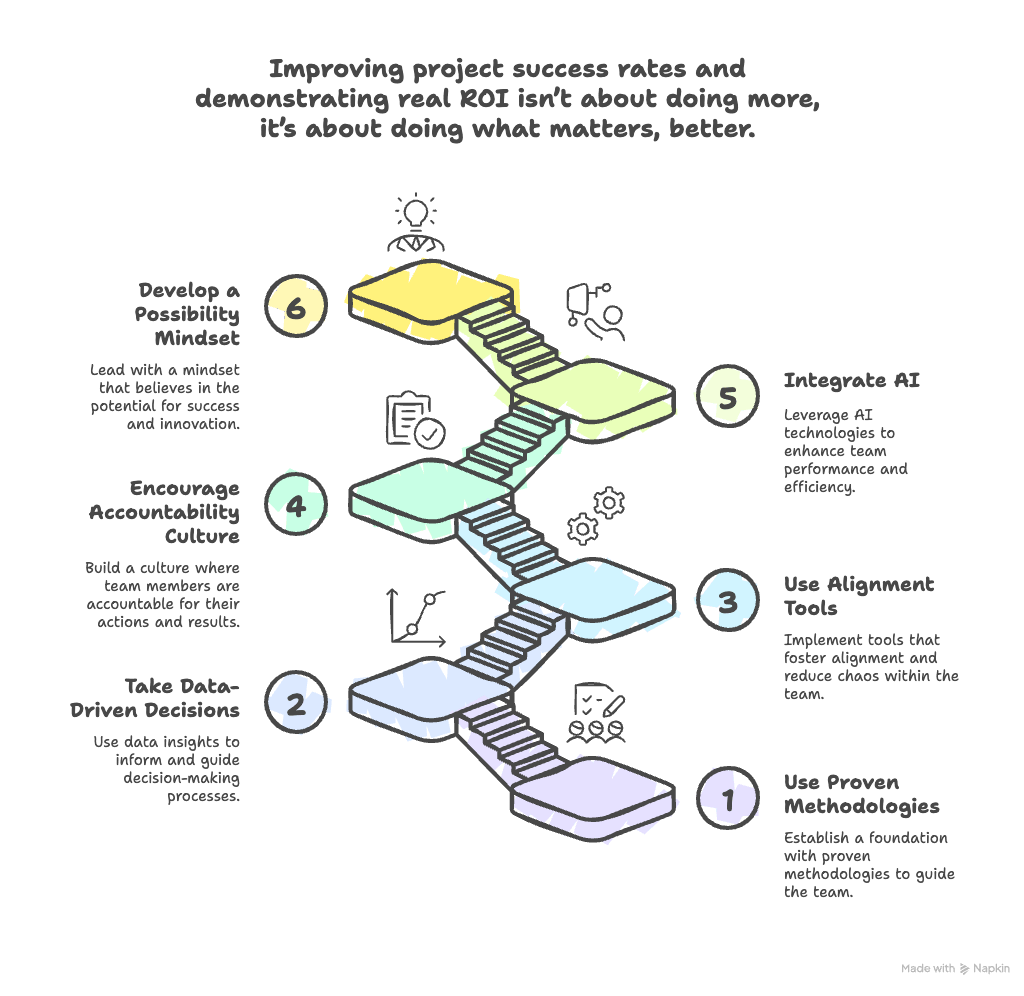READ TIME: 7 minutes
Learn six strategies to improve your project success rates
Over the years, I’ve watched projects, both big and small, get stuck in the same loop: great intentions, fuzzy execution, and disappointment in the results. As someone who’s led multi-million dollar construction, retail, and industrial projects, one thing has become clear: success isn’t about ticking boxes, if you want to improve project success rates.
It’s about delivering real, measurable outcomes, on time, within budget, and in a way that stakeholders feel and value.
In today’s high-pressure environment, there’s little tolerance for missed deadlines or bloated budgets. So how do you turn project investments into tangible results?
Let’s unpack six strategies that forward-thinking organisations are embracing, and how each one directly improves project outcomes.
Table of Contents
Strategy 1: Use Defined Project Management Methodologies Well
You don’t have to reinvent the wheel. Structured frameworks like Agile, PRINCE2, or PMBOK offer clear roadmaps. But what really moves the needle is how well they are applied.
Take IBM. They didn’t just introduce Agile, they transformed around it.
Global teams were trained, roles redefined, and systems aligned.
The result?
Reduced delivery times, improved quality, and greater client satisfaction.
How defined methodologies improves outcomes:
- Clearer scope and role definitions
- Consistent processes that reduce rework
- Faster decision cycles and improved stakeholder alignment
- Better risk management through phased planning
Choose the framework that fits your environment, and invest in training, support, and reinforcement.
Frameworks fail when they are only applied at surface level.
Strategy 2: Make Data the Backbone of Your Decisions
In high-stakes delivery roles, we often feel the tug between speed and precision. That’s where data becomes your best ally.
Google does this brilliantly.
Their teams don’t rely on gut feel, they track and analyse real-time data to shape strategy and predict outcomes.
How data improves project outcomes:
- Improved accuracy – Replace gut calls with reliable forecasts
- Risk mitigation – Spot issues before they escalate
- Resource optimisation – Allocate effort where it matters most
- Real-time course correction – Pivot before it’s too late
- Better stakeholder reporting – Show ROI with clarity, not spin
Ask yourself, are we reacting to problems, or using data to get ahead of them?
Strategy 3: Invest in the Right Tools and Make Them Work for You
I’ve seen strong teams crumble under poor systems, and average teams thrive when tools support them well.
Platforms like Asana, Microsoft Project, Wrike, and Officetimeline are more than digital checklists. They drive alignment, clarity, and pace across dispersed teams.
A Forrester study found that organisations using structured PM tools increased forecast accuracy and cut down delivery delays significantly.
How the right tools improve project outcomes:
- Enhanced visibility for leadership and delivery teams
- Fewer communication gaps through centralised updates
- Automated reporting, reducing admin load
- Better planning and coordination of interdependent tasks
Don’t just buy the tool.
Train your people.
Integrate it into workflows.
Lead by example in using it.
Strategy 4: Build a Culture of Accountability and Continuous Improvement
Project success isn’t just about tools and timelines. It’s about people.
Some of the best teams I’ve worked with shared one thing, they owned their outcomes. They celebrated wins but also dissected delays, asking: “What can we learn from this?”
On a national retail rollout I led, we implemented post-project reviews that went beyond gut feel. We analysed delays, change orders, and supplier data. That mix of honest reflection and hard evidence fed directly into stronger planning and fewer errors in the next phase.
How culture improves project outcomes:
- Teams learn faster, make fewer repeat mistakes
- Ownership mindset boosts engagement and reliability
- Mistakes become learning moments, not finger-pointing sessions
- Improved relationships with stakeholders who see consistent improvement
Leaders, model accountability.
Then implement regular check-ins, retrospectives, and feedback loops.
Culture is built in the small things, every day.
Strategy 5: Integrate AI to Do the Heavy Lifting
AI isn’t about replacing people. It’s about amplifying them.
Siemens integrated AI into their project systems to automate updates, predict delays, and reallocate resources.
The result?
A 30% cut in delays and 15% cost savings.
Today, AI tools can scan contracts for risks, flag schedule conflicts, do gantt charts, forecast issues that might affect the critical path, and even write progress updates. That frees up teams to focus on strategy and stakeholder engagement.
How AI improves project outcomes:
- Reduces human error in routine tasks
- Speeds up data analysis and risk identification
- Predicts delays before they happen
- Increases planning accuracy and resource utilisation
Use AI in one area, like scheduling or risk tracking, and scale once your team gains confidence.
Strategy 6: Cultivate a Can-Do Attitude and Positive Mindset
Finally, mindset matters more than most people realise.
As a project leader, your attitude sets the tone.
A “can-do” culture invites resourcefulness, resilience, and innovation.
When leaders show up with a solution-first mindset, teams rise to meet that energy.
Project managers are uniquely placed to influence team behaviour. If you lead with clarity, optimism, and purpose, your team starts to see their role not just as executing tasks, but as delivering value.
How mindset improves project outcomes:
- Motivates creative problem-solving during challenges
- Keeps teams focused on possibilities instead of barriers
- Builds psychological safety, where people speak up early
- Strengthens team morale during tight deadlines
As a leader, encourage this daily:
Celebrate progress.
Share lessons.
Remind people of the “why” behind their work.

Resources to Make the next Move
If you are ready to take action, here are some books and articles, to help you move forward:
Recommended Books
- Measure What Matters by John Doerr – Learn how OKRs link effort to impact
- The Five Dysfunctions of a Team by Patrick Lencioni – For building accountability-driven teams
- AI Superpowers by Kai-Fu Lee – A good primer on AI in business strategy
- Scrum: The Art of Doing Twice the Work in Half the Time by Jeff Sutherland
Articles
- IBM Agile Case Study: IBM Agile Transformation
- Google Data-Driven Project Management: relevant Google blog on data-driven operations
- Siemens AI Use Case: SmartDev AI Project Management
- Forrester PPM Research: Forrester on PPM ROI
- PRINCE2 Data Insights: PRINCE2 Blog
Final Thoughts
Improving project success rates and demonstrating real ROI isn’t about doing more, it’s about doing what matters, better.
- Ground your team in proven methodologies
- Let data guide your decisions
- Use tools that drive alignment, not chaos
- Build a culture of accountability
- Leverage AI to lift performance
- And above all, lead with a mindset that believes in possibility
These aren’t just nice-to-haves.
They’re essentials for any leader looking to improve project success rates and about delivering outcomes that count.
Share This If It Resonated
If this post struck a chord or reminded you of a project you’re working on, share it with someone who’s walking the same path.
And if you’re a project leader trying to build real momentum in your team, know this: change doesn’t need to be massive to be meaningful. It just needs to start with one step forward.
Let’s deliver results, not just effort.



